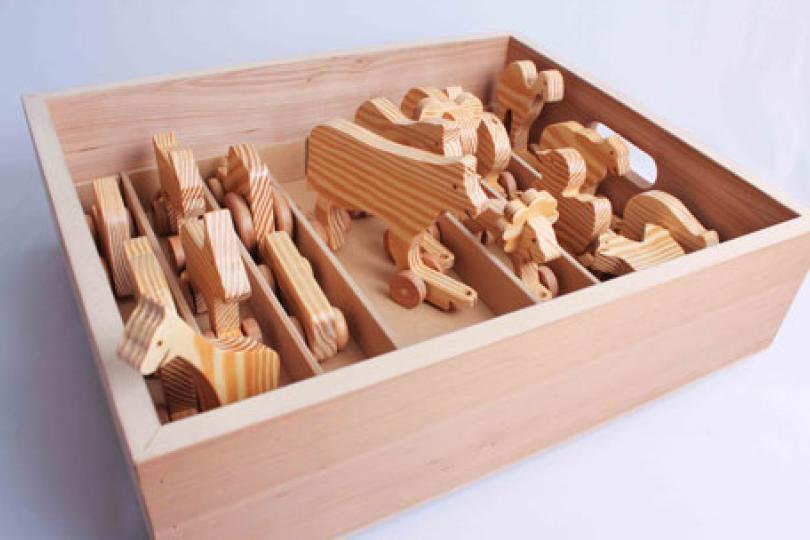Checklist for toys focuses on deeper values
Editor's note: The following was originally published in the Burlington Free Press in 2001. Although Alicia says she has mellowed in the years since it was written, she still makes elk hide drums and rattles and gives them as gifts. We also published Fellow Judith Rubin's story on rethinking children's gifts, which quotes this one.
My 4-year-old daughter, Camille, is in love with her new Barbie sneakers. She spent a whole day showing them off to strangers. She would extend a food and turn it this way and that, as if to catch the best light. I can see their appeal, with their bright "diamond" studs and pink bubble gum soles.
After all, my mother and I picked them out. But they represent a compromise to me, not a heartfelt endorsement. Here's the argument: she wants a Barbie, she needs shoes; so, better these than the doll.
My husband and I are resisting a tide of requests for toys, including a Barbie. Despite being urged by our political leaders to shop for America, and by Camille to shop for her birthday, we are trying to avoid joining any shopping crusade - no matter how good the cause.
Like many of our parenting decisions, this one feels like a slow back crawl against a very strong current. We can't even hope to stay in place. We can only try not to get swept too far downstream, perhaps to be buried in the out wash of our family's possessions. And I know from conversations with other parents, we are far from alone.
What does it matter what our children play with as long as they are safe? That's enough on some days. But on days of greater clarity I can't slice our toy choies away from our deeper values. Nor do I want to. My husband and I have lived in wild places among people with strong ties to the Earth. And certainly there are many Vermonters living - or wanting and trying to live - this way. I want to see toys through the eyes of ancient ways with a vision of a hopeful future.
As a spiritual practice, my family expresses our gratitude for the people, plants, animals and spirits that connect and nurture us. At heart, I believe we all have an indigenous soul that feels an Old Earth reverence.
Whatever our spiritual orientation, we are, as a nation, entering a time of year - and history - that causes sacred beliefs and the material world to cross paths with special intensity. So, in that spirit, I offer the following checklist:
- Will this toy turn into dirt - i.e., could I compost it?
The Earth engages, as it has for millennium, in the practice of recycling: leaves into soil, stones into sand, water into life. Snowmen with their carrot noses, mud pies decorated with daisies, rock dams in a summer stream, driftwood castles on a beach and fall leaves dropped into a stormy rain gutter, all have this magical, flowing-on quality. Toys made of wood, paper, stone and snow are satisfying in their transient nature. They will be gone. We will be gone. And life goes on.
- Do I know who made this toy?
If something is constructed from materials at hand, taken from the yard or recycling bin, the answer is yes, we made this toy. Cardboard box houses wallpapered with old gift wrap have given us both hours of fun. And making the toy is as fun as using it.
This question also leads us on a search for the folk artist hidden in each of us - the friends, family and larger community surrounding us. Camille's Grampy once made a truck with his brother out of wooden spools and rubber bands. He said they even notched the wheels so it could climb over obstacles. There is a retired man in a nearby village who devotes his time to creating clever, affordable wooden toys. At craft festivals, we are closer to the hands which made the toy.
- Is this toy beautiful?
Human hands bestow an awkward grace, a uniqueness, lacking in toys cranked out effortlessly by machine. Not only do handmade toys celebrate our humanity, their very creation contains the possibility of worship, thoughts focused on the toy, the child and the worlds that hold them. Because handmade toys are most often made out of wood, cloth, paper or other natural materials they also show the grain or fiber of the material used. You can still see them in the spirit of the sacrificed object. They have texture, which is beautiful.
- Will this toy capture a child's imagination?
The best part of a versatile toy and a fertile imagination is that you need fewer of these toys. I have been reminded by my daughter that desire is a magical thing with gossamer wings; it flits and floats in front of us, always a bit out of reach. The moment a desire is caught it springs anew.
We would be wise to learn from large toy manufacturers what they cleverly discovered - toys that come in as one in a series, Harry Potter, for example, quickly lead to more requests - as do those that can wear a thousand outfits and accessories, like, well, Barbie.
So, does this mean from now on people entering our house have crossed over into a plastics-free zone? Far from it.
But I am heartened to begin to articulate a vision of toys with Earth and soul-honoring traits. Now I can actively seek out and make toys that fit with our family's deeper values. And with this list, I will be steered away from toys whose manufacture generates toxic substances, whose creation fuels sweatshop labor. Then, seeing toys through the eyes of a child and with the wisdom of an adult, can become a part of the celebration of this time of year.


